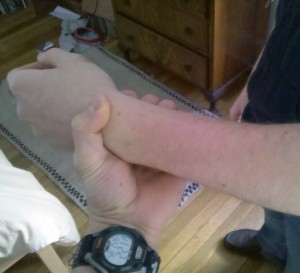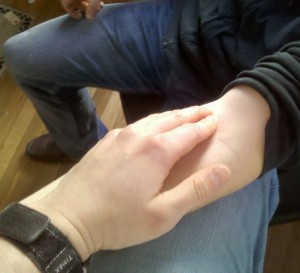For other Vital Signs posts, see: Respirations and Blood Pressure
Ah, the almighty pulse. If I have a favorite vital sign, this is it; let me lay hands on a patient and take a pulse and my assessment is already well under way.
On the conscious patient our go-to point is the radial pulse, and like golf, mastering the radial is all in the grip. Techniques may vary here, but I always find the radial easier to palpate if you approach from the ulnar side of the arm, coming “underneath” rather than over the top of the radius. This also lets you take a pulse while easily holding onto their limb, rather than forcing you to find a place to rest it, or supporting the arm with one hand while you palpate with the other. Just grab and count, very natural. If you have no luck, you can always keep hold of their arm while using your other hand to do some searching.
The textbooks always seem to show this being done with two delicate fingers, which is silly; more fingers means more coverage, so I always use at least three. (Your little finger is kinda short, otherwise it’d be four.) Use a moderate pressure, but if you’re having trouble, try pressing both lighter and firmer, as well as moving to different spots. (While I usually wear my watch in the normal position, you’ll notice here that when taking a pulse this way, I flip it around my wrist so I can see the face.)
The main way to ensure you’re never baffled by the pulse, however, is by always being willing to look elsewhere. Some people simply won’t have a radial, and this fact may or may not have significance — it may mean they’re hypotensive, or that their arm is locally hypoperfused, but it also may be a chronic condition. Hemodialysis patients with arterio-venous fistulas in their arm are especially notorious for having peculiar or absent radial pulses, as the arteries near the fistula have been scavenged and rerouted. Make like a picky renter — go elsewhere!
Your next attempt after the radial should be the brachial. Now, in classes and textbooks I have always been taught to look for a radial in the upper arm, beneath the bicep, but I’ve never had luck with this. Rather, my target is the antecubital fossa, the same territory made popular by blood pressures and large-bore IV sticks.
Again, positioning is key here. To effectively feel this pulse, the elbow should be in full extension, but relaxed. Depending on the patient’s position, you may accomplish this by wrapping your arm around theirs and holding their elbow in your hand, but from your bench seat in the truck, an easier way to do it is to simply rest their elbow on your knee. (Either way, it’s important to support them at the elbow, because this allows gravity to force their arm into extension.) The brachial can be a real lifesaver when a radial isn’t forthcoming, and I go to it readily and often.
Logically, the next step would be a carotid pulse, but the truth is that on conscious, alert patients, this is always a little awkward; people don’t like having their neck touched. If they need it, they need it, but for the routine pulse check, I try to steer clear. The same goes for a femoral pulse, for the same reasons; there was a story at my old service of a brash young EMT who got canned for “feeling a femoral” on an inebriated coed from a campus we served.
Instead, if I can’t find a radial or brachial on either arm, I’ll often take an apical “pulse,” simply auscultating at the chest for heart sounds. This is not, strictly speaking, a pulse, insofar as it’s not counting actual perfusing beats so much as counting any cardiac noise (it therefore tells you nothing about blood pressure), but it’s a good fallback — and if you’re very suave it can even yield additional clinical information, regarding murmurs, rubs, etc.
Here are a some other tricks that can be useful:
- Inflate a BP cuff and count the bounces on the sphygmomanometer needle. Although this is not an indicator of systolic or diastolic pressure, it is a legitimate way to measure a pulse.
- If pulse oximetry is available, the device will usually calculate a pulse for you, and if there’s a displayed waveform you can also confirm it from that.
- The aforementioned AV fistulas can be used to your advantage. Gentle palpation of visible, active fistulas should let you feel a pulsing vibration called a thrill (an indicator of healthy flow), and this is easily counted for an accurate pulse rate. (Auscultating at the fistula should reveal a buzzing sound called bruit, which can be used similarly.)
- If you’re able to locate a difficult pulse point, such as a dorsalis pedis, X’ng the spot with a pen can make subsequent checks much easier.
- Lowering the arm below the level of the heart can occasionally make a radial more readily palpable, especially in hypotensive situations.
Finally, when all else fails, remember your perpetual fallback: skin signs. A patient with no available pulses and no obtainable blood pressure can still give you a general sense of perfusion, both centrally and to each extremity, if you assess the color and temperature of his skin. (This is especially valuable for infants, for whom proper pulse checks can be difficult, and blood pressures even more so.) And then there’s the sidekick to this, which is capillary refill. Current teaching is that cap refill is not a meaningful sign except in the very young, because numerous chronic conditions can cause delayed refill without poor arterial pressure, and this is true; a slow cap refill in an adult shouldn’t mean much to you. However, a rapid refill is still a pretty specific sign of good perfusion, because there’s not many conditions that can fake that (with the possibly exception of distributive shocks, such as septic or anaphylactic). A quick pat-down is an ever-ready way to rapidly assess anyone’s hemodynamic status within a couple seconds.


You should see what all a Chinese Dr. can tell you with a pulse. I’ve read but little on the subject by Dr. Michael Tierra but was impressed. Bu then again, I could be just easy to impress.
Great article.
I have often used your technique for checking a radial pulse. Only, rather than “resting” my hand on the anterior portion of their wrist, I approach from the posterior side. Same basic technique, and I still use 3 fingers. I just go “over the top” rather than “under the bottom” (if that makes any sense). Now I’m going to have to try your approach to see if it works better.
I must say, I have heard of many tricks for finding a difficult pulse, but the BP cuff method is something that I simply never thought of. Your absolutely right. It’s easy and accurate.
What are some effective high blood pressure medications?
Connie, if you’re asking for specific advice, you should talk to your doctor! In general, common meds for BP include thiazides, ACE inhibitors, calcium channel blockers, beta blockers, and more.
Why brachial pulse should be taken acurately>